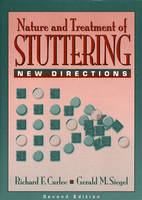
The Nature and Treatment of Stuttering
Pearson (Verlag)
978-0-205-16336-6 (ISBN)
- Titel ist leider vergriffen;
keine Neuauflage - Artikel merken
This long awaited revision was written based on the belief that clinical professionals should have specialized knowledge about a disorder, the people it affects, and how it can be managed effectively, and that such knowledge should be based on empirical scientific studies. The best and most authoritative sources for such information are the individuals who have been involved in its acquisition. Thus, this book's authors include researchers who gathered much of the data that are discussed, theorists who attempt to explain such data, and clinicians who developed and tested many of the assessment and management procedures currently employed with children and adults who stutter.
This contributed text covers the epidemiology, characteristics, etiological accounts and treatment of stuttering. It provides thorough, scholarly reviews of what is known about stuttering and its clinical management. It is informative, comprehensive, current, and authoritative in its coverage. It is intended to be both a reference for professionals and a text for students in graduate research and clinical training programs.
Contributors.
Preface.
I. CHILDHOOD STUTTERING.
1. Epidemiology and Genetics of Stuttering, Susan Felsenfeld.
2. Home Environments and Parent-Child Interaction in Childhood Stuttering, Ehud Yairi.
3. Disfluency Characteristics of Childhood Stuttering, Ehud Yairi
4. Learning and Its Role in Stuttering Development, C. Woodruff Starkweather.
II. STUTTERER-NONSTUTTERER DIFFERENCES.
5. Stuttering: A Psycholinguistic Perspective, Nan Bernstein Ratner.
6. Respiratory and Laryngeal Control in Stuttering, Margaret Denny & Anne Smith.
7. Brain Imaging Contributions, Ben C. Watson & Francis J. Freeman.
III. ETIOLOGICAL VIEWS OF STUTTERING.
8. Stuttering as an Anticipatory Struggle Reaction, Oliver Bloodstein.
9. Stuttering as a Covert Repair Phenomenon, Herman Kolk & Albert Postma.
10. Stuttering: A Dynamic, Multifactorial Model, Anne Smith & Ellen Kelly.
11. Stuttering: Why Science Hasn't Solved It, William H. Perkins.
IV. CLINICAL MANAGEMENT OF CHILDREN.
12. Evaluating Childhood Stuttering, Edward G. Conture.
13. Therapy for Younger Children, C. Woodruff Starkweather.
14. Therapy for Children's Stuttering and Emotions, Barry Guitar.
15. Clinical Management of Children: Direct Management Strategies, Peter R. Ramig & Ellen M. Bennett.
16. Managing of Cluttering and Related Fluency Disorders, Kenneth O. St. Louis & Florence L. Meyers.
V. CLINICAL MANAGEMENT OF ADULTS.
17. Modifying Stuttering — The Stutterer's Reactive Behavior: Perspectives on Past, Present, and Future, David Prins.
18. Designing and Implementing a Strategy to Control Stuttered Speech in Adults, Mark Onslow & Ann Packman.
19. Instrumentation for the Assessment and Treatment of Stuttering, Klaus Bakker.
20. Stuttering and the Measurement of Speech Naturalness, Nicholas Schiavetti & Dale Metz.
21. Self-Measurement and Evaluating Stuttering Treatment Efficacy, Roger J. Ingham and Anne K. Cordes.
Afterword.
Index.
| Erscheint lt. Verlag | 10.10.1996 |
|---|---|
| Sprache | englisch |
| Maße | 242 x 183 mm |
| Gewicht | 567 g |
| Themenwelt | Medizin / Pharmazie ► Gesundheitsfachberufe ► Logopädie |
| ISBN-10 | 0-205-16336-X / 020516336X |
| ISBN-13 | 978-0-205-16336-6 / 9780205163366 |
| Zustand | Neuware |
| Haben Sie eine Frage zum Produkt? |
aus dem Bereich


